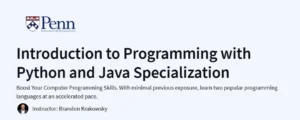What will you learn in Introduction to Neural Networks and PyTorch Course
Understand the architecture and operation of deep neural networks.
Build and train deep learning models using PyTorch.
Apply activation functions, loss functions, and optimizers effectively.
Use convolutional neural networks (CNNs) for image classification tasks.
Program Overview
Module 1: Introduction to Deep Learning and PyTorch
⏱️ 1 week
Topics: Overview of neural networks, PyTorch setup, tensors
Hands-on: Tensor operations, PyTorch basics
Module 2: Building Neural Networks with PyTorch
⏱️ 1 week
Topics: Model architecture, forward/backward pass, model training
Hands-on: Build and train a simple feedforward neural network
Module 3: Activation and Loss Functions
⏱️ 1 week
Topics: Sigmoid, ReLU, Tanh, cross-entropy, MSE
Hands-on: Experiment with different activation/loss functions
Module 4: Optimization and Backpropagation
⏱️ 1 week
Topics: Gradient descent, backpropagation, optimizers
Hands-on: Implement SGD and Adam for model optimization
Module 5: Convolutional Neural Networks (CNNs)
⏱️ 1 week
Topics: Convolutional layers, pooling, CNN architecture
Hands-on: Build and train a CNN for image recognition
Module 6: Model Evaluation and Deployment
⏱️ 1 week
Topics: Evaluation metrics, overfitting, saving models
Hands-on: Model evaluation and serialization
Get certificate
Job Outlook
High demand for deep learning engineers and AI practitioners.
Average salary ranges from $90K–$150K+ depending on role and location.
Skills in PyTorch are sought after in computer vision, NLP, and ML research.
Specification: Introduction to Neural Networks and PyTorch Course
|
FAQs
- Basic Python knowledge is recommended but not mandatory.
- Prior machine learning experience is helpful but not required.
- Step-by-step instructions introduce neural network concepts from scratch.
- Hands-on exercises guide learners through coding with PyTorch.
- Beginners can gradually build confidence in both theory and implementation.
- Learners build simple neural networks using PyTorch.
- Exercises include tasks such as training, evaluating, and optimizing models.
- Realistic datasets are used to simulate practical applications.
- Step-by-step labs reinforce understanding of layers, activation functions, and loss computation.
- Hands-on practice prepares learners for more advanced deep learning courses.
- PyTorch fundamentals are taught with practical examples.
- Learners learn to implement models for image classification, regression, and other tasks.
- Concepts include tensor operations, gradients, and optimization techniques.
- Skills gained are applicable to research, AI projects, and prototyping neural networks.
- The course provides a foundation for advanced AI and deep learning specialization.
- Neural networks are core components of modern AI systems.
- PyTorch is widely used in industry and research for deep learning projects.
- Skills gained enhance employability for entry-level ML or AI roles.
- Knowledge supports further learning in advanced AI, computer vision, and NLP.
- Hands-on coding experience demonstrates practical ability to potential employers.
- Estimated completion is around 3–5 weeks at a part-time pace.
- Weekly effort of 4–6 hours is generally sufficient for lectures and coding exercises.
- Regular practice in building and training models reinforces understanding.
- Revisiting exercises or experimenting with custom datasets may require extra time.
- Consistent engagement ensures learners develop both conceptual understanding and practical PyTorch skills.





